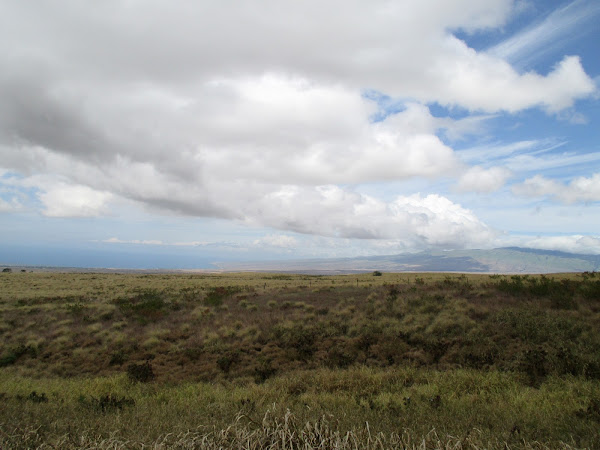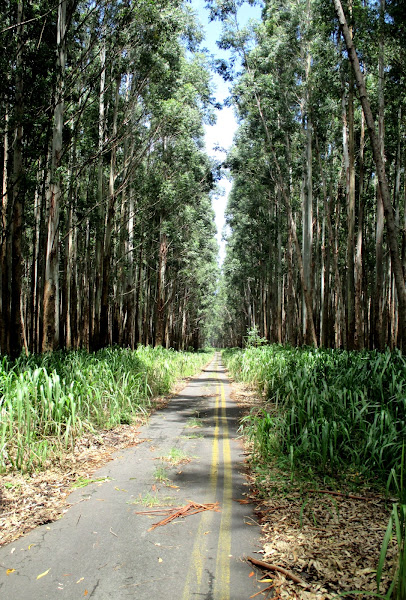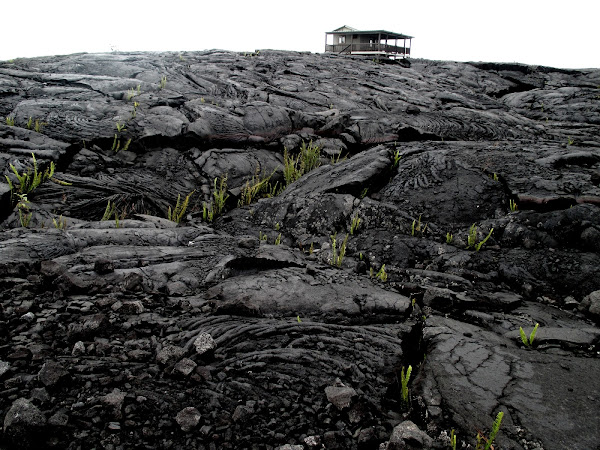Last fall I had the pleasure of going on vacation to Hawaii with Monica. I had been there once before half my life ago. But this time we'd be going to The Big Island of Hawaii and avoiding Oahu (and therefore the tourist-crowded beaches of Waikiki), making it very different from my first trip.
We flew into Kona late at night and picked up a Mazda 3 to drive around the island. The next morning we got breakfast at Bongo Bens in downtown Kailua Kona. Kona is known for a few things; the most recognizable product on the mainland is probably their coffee. I also knew it was the hometown of one of my favorite bands, Pepper, and the location of the Kona Brewing Company, which makes some decent beers that I've seen sold as far away as Chicago. Walking around Kona after breakfast we found the Royal Kona Resort, which claims to be the home of the original Mai Thai. I'm pretty sure they're not the only ones to make that claim though.
We set out to circumnavigate The Big Island. Getting out of the populated areas it reminded me more of Iceland than anywhere tropical. It's the youngest of all the Hawaiian islands, and also the most geologically unstable. So there was a lot of black and red lava rock. And many places where grass and trees didn't grow.

The Big Island might be able to give Montana a run for being "big sky" country. This particular area had a wild fire that destroyed most of the foliage not too long ago.
Hopping on the Belt Road we stopped to take some pictures and a dust devil formed just a few feet from us. It dissipated after about a minute and probably wasn't large enough to be dangerous (I'd estimate 6-7 feet in diameter), but it did provide a surge of adrenaline to be that close to such a rare and unpredictable natural phenomenon.

An old, no longer used road not marked on any map. There were a lot of animal noises coming from the forest on either side along with waist-high grass, which meant we had no idea what was in there.
After passing through Waimea we took a turn onto a road that was marked simply "Scenic Drive." This eventually lead us to the Hawaii Tropical Botanical Gardens and the Onomea Trail. It was a fun area to explore and the part of the island I remember being the most full of diverse plants and teeming with life.

An inlet in Onomea Bay, it was very private and we were told locals sometimes swim there despite the rocky obsidian beach.

Another Onomea Bay inlet, this one with some intense waves that sprayed up to my height when they crashed upon the rocks.
We diverged from the highway again to hike around Akaka Falls, which is a state park focused on a waterfall over 400 feet high. I was impressed by how many state parks Hawaii has, especially considering how accessible and cheap they are - they just made you pay for parking, and it was otherwise free to get in and walk around.

Akaka Falls in all its 422 foot glory. The sense of scale is totally lost here, but it kind of was for us too because the viewing platform is so far away.
We descended into Hilo for lunch at a cafe. We got fresh fish and walked around the surf-side town that was very empty during the early afternoon.
Our next stop was the Kalapana viewing site in the Hawaii Volcanoes National Park. This put us on top of the volcano that was active during our time there. We were a little worried that it would interfere with our plans as the lava flow was moving at a pretty rapid pace of 50-100 yards a day and often turning in unpredictable directions. Luckily it did not cover the freeway - which was a major fear for residents as it would force them to evacuate as there is only a single road going into some of the neighborhoods there. There were updates every 15 minutes or so on the radio so we always knew what the situation was. When we got there we had to park outside the lava fields and then continue on foot. Feeling the warmth of the rock and knowing that flowing lava could just be inches below the surface was incredible.

Land on the Kalapana lava fields is passed down hereditarily to native Hawaiins and is not taxed, so some choose to build houses there, even knowing they could be destroyed at any time by the volcano.
We then turned around to check out Rainbow Falls. This was a much smaller park and waterfall than Akaka. And because we got there when it was cloudy and the sun was setting it did not live up to its name and give us a rainbow.
Back in Hilo we had dinner at Cafe 100, which we had been told was a local favorite. We ate the specialty, Loco Moco, which is essentially a layered dish consisting of rice, a sausage patty, a fried egg, and a brown gravy, in that order. It was rich and tasted very salty and fattening. I won't be craving it any time soon.
Finally, we drove into the center of the island and up the mountain of Mauna Kea. It was dark, as there were no street lights on the road, so we had only the car's headlights and their reflections to guide us. Nor were there many other cars. Add to that the rain and fog and the visibility became extremely low. At points I could only see a few feet in front of me. A few miles that the map said would take us 20 minutes took well over an hour. And despite the fact that the speed limit was 50 or 60 MPH, the tiny car never made it above 25 on that 15% slope. It was easily the most harrowing drive of my life.
When we finally burst through the clouds it was a magical, surreal experience. The night sky was so bright and the air so clear that I felt like I could see forever. The water bottles had been crinkling from the pressure change and I could discernibly feel the lower oxygen amount. At 9,000 feet the visitor center for the observatory is only a hundred or so feet above the clouds, but it was enough. I wish I could've captured what it was like in a picture, but given the light levels and the fact that using a flash would ruin mine and everyone else's night vision none of the shots I did take turned out. So you'll have to trust me: it was nothing short of amazing.
They had a guide with a laser pointing out constellations and constantly talking about what we could see and the site itself. Being that high put us above the clouds and over 60% of the water vapor in the Earth's atmosphere. So stargazing there is like very few other points on the planet. It's also one of the only places it's guaranteed you'll want pants and a warm jacket in Hawaii.
I've always been a huge fan of space and astronomy and being up there was easily the highlight of the trip for me. They had several huge telescopes set up for the public to use and seeing the rings of Saturn with my own eyes - live, not some picture - was awe-inspiring. I found myself continually going back to that telescope, even though others were pointed in some interesting directions, like Mars and Polaris. I hope that the current tensions about building a new telescope are resolved, as it was an experience I want everyone to be able to have well into the future. If you don't know what I'm talking about, the best piece I've seen on it is here.
When we finally got tired of the cold we headed back down the mountain, which was a much different experience than the drive up: mostly, faster. I was braking the entire drive down just to keep control of the car. When the land finally leveled out near sea level I could feel the tension seep out of me. In a single day we had seen multiple waterfalls, lava fields, beaches, planets and stars, scaled a mountain and put close to 300 miles on the rental car.